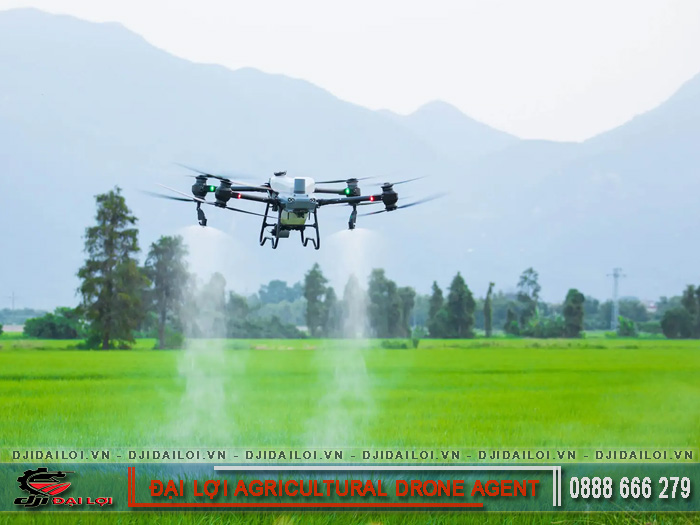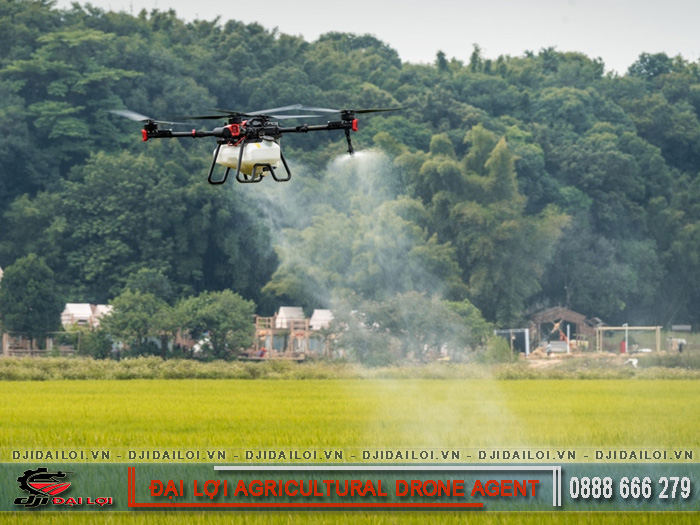
To effectively manage drone spraying investment costs, farmers need to understand each component of the total expense. This allows for accurate budgeting, avoiding overspending, and optimizing capital usage. Below are the main cost categories to consider when planning to invest in an agricultural spraying drone.
Most of the initial expense comes from purchasing the drone sprayer and related accessories such as pumps, tanks, nozzles, controllers, and positioning sensors. Prices vary depending on brand and model; for example, DJI T25P or T70P range from 150 to 300 million VND.
Farmers should choose a device suitable for their cultivation area to avoid overspending on high-capacity models that increase unnecessary drone spraying investment costs.
Batteries are the most significant consumable component, accounting for about 15-20% of the total cost. A quality lithium battery can spray continuously for 20-25 minutes before needing a recharge. Other consumables such as nozzles, hoses, and control boards also require periodic replacement.
Investing in energy-efficient batteries helps reduce long-term operating expenses.
After 6-12 months of use, drones need inspection of propellers, sensors, and spray system performance. Regular maintenance costs make up about 3-5% of the equipment’s annual value. Without proper maintenance, the device may fail prematurely, leading to higher long-term drone spraying investment costs.
Operators should undergo training to ensure safe and efficient usage. Training fees usually range from 2-5 million VND per course. In addition, equipment insurance helps minimize losses from accidents or unexpected damage - a small investment that can save substantial future expenses.
According to data, manual spraying costs around 250,000-300,000 VND per hectare, while drone spraying averages only 80,000-100,000 VND per hectare - saving 60-70% in labor costs.
|
Category |
Manual Spraying |
Drone Spraying |
|---|---|---|
|
Labor cost |
High (2-3 people/ha) |
Low (1 operator) |
|
Spraying time |
2-3 hours/ha |
10-15 minutes/ha |
|
Pesticide use |
20-30% higher |
More precise, less waste |
|
Safety level |
Direct chemical exposure |
Fully contact-free |
Drones significantly reduce labor during peak seasons. A small farm needs only one operator, independent of weather or seasonal workers. At the same time, pesticide usage drops by 20-30%, helping to optimize drone spraying investment costs while minimizing environmental impact.
For continuous-use models, the payback period is just 12-18 months. After deducting costs for batteries, maintenance, and labor, profits can reach 25-30% per crop cycle - an attractive return compared to conventional agricultural machinery, proving the long-term efficiency of drone sprayers.
Before investing, calculate average area and spraying frequency per crop. For areas under 10 hectares, a 10-20-liter model is sufficient; farms above 20 hectares should use 30-40-liter drones for better efficiency and reduced cost per hectare. Choosing the right capacity avoids unnecessary drone spraying investment costs.
DJI models such as T25P, T40, and T50 stand out with RTK positioning, precision spraying, and high durability. Compared to other brands, DJI offers a stable accessory ecosystem, easy maintenance, and strong technical support in Vietnam - all of which reduce long-term costs.
High-capacity, fast-charging batteries with more than 800 cycles significantly lower costs over 3-5 years. Selecting waterproof, dust-resistant, and easy-to-clean materials also prevents damage in humid farming environments.

Group purchases allow small farms or cooperatives to share investment costs. This method can reduce the initial expense by 30-40% while maintaining full equipment functionality - a smart way to minimize drone spraying investment costs without compromising quality.
Routine maintenance ensures stable drone performance and prolongs battery and motor life. Combining it with agricultural insurance minimizes financial risk from accidents or malfunctions.
Many local governments offer 0-3% interest loans for drone spraying investments. Farmers should stay updated on these programs to reduce real investment costs, especially under digital agriculture initiatives.
Studies show that using drone sprayers saves an average of 8-10 million VND per hectare per year. For a 10-hectare farm, annual savings reach 80-100 million VND - nearly half the drone’s purchase price. This highlights both sustainability and rapid payback potential.
Common risks include battery failure, sensor errors, or crashes from improper operation. To minimize these:
These steps protect drone spraying investment costs and prevent unplanned expenses.
In the next five years, agricultural drones will expand beyond spraying to include AI-based plant health monitoring and precision dosage adjustment. This advancement will further improve productivity and reduce farming costs, allowing smallholders to achieve greater profitability with the same level of investment.
⇒ Compared to traditional methods, investing in drone sprayers helps farmers cut 60-70% in labor costs and 20-30% in pesticide usage. When operated correctly, this is a clearly profitable investment that brings small farmers closer to sustainable, technology-driven agriculture.
Yes. Spraying drones can adjust pressure and flow rate, making them suitable for rice, corn, coffee, vegetables, and fruit trees for optimal performance.
Absolutely. Many providers offer spraying services that allow small farms to save on drone spraying investment costs and pay only by actual sprayed area.
Key factors include tank capacity, battery type, RTK technology, brand, and component durability - each directly impacting price and operating expenses.
Not recommended. Heavy rain or strong wind reduces flight precision, increases pesticide waste, and raises the risk of damage, leading to higher drone spraying investment costs.
Both. Updating flight control software ensures stable operation, prevents system errors, and helps spraying drones perform efficiently with lower energy consumption.